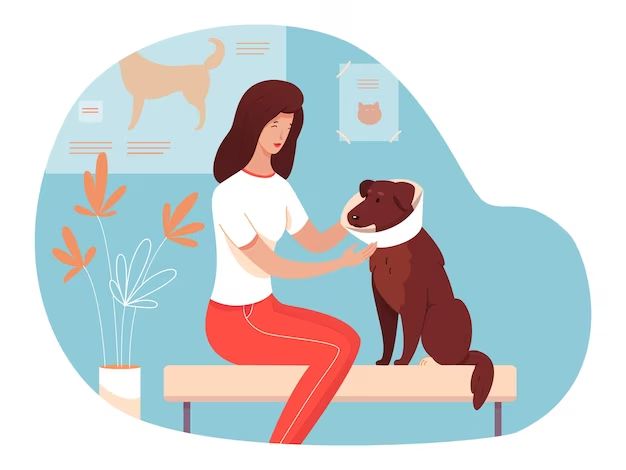Introduction
Cancer is a disease characterized by uncontrolled cell growth. There are over 100 different types of cancer that can affect any part of the body. Cancer treatments like chemotherapy, radiation, and surgery aim to kill cancer cells but they also damage healthy cells.
These cancer treatments often severely weaken the immune system, leaving patients more susceptible to infections. Chemotherapy drugs can reduce white blood cell counts, limiting the body’s ability to fight off bacteria and viruses. Radiation also impacts bone marrow where blood cells are made. Surgery puts patients at risk of surgical site infections.
With compromised immune systems, cancer patients have to be very careful to avoid exposure to germs and pathogens. This means taking precautions around animals that could potentially carry harmful bacteria.
Weakened Immune Systems
One of the main reasons cancer patients need to be careful around dogs is because cancer treatments like chemotherapy often weaken the immune system. Chemotherapy works by killing rapidly dividing cancer cells, but it also damages healthy cells like the cells in bone marrow that produce white blood cells. This lowers the white blood cell count, weakening the immune system.

With fewer white blood cells to fight off infection, cancer patients undergoing chemotherapy become immunocompromised. Their weakened immune systems have a harder time protecting the body against bacteria, viruses, fungi, and other pathogens. Even common germs that don’t affect people with healthy immune systems can cause major illnesses in those with compromised immune function.
Infection Risks
Cancer patients often have weakened immune systems due to the disease itself and its treatments like chemotherapy. Chemotherapy targets rapidly dividing cancer cells, but it also kills healthy immune cells that help fight off infection. Radiation therapy can also damage the bone marrow where immune cells are made. This leaves cancer patients more susceptible to illnesses that a healthy immune system could easily fight off.
A common infection in cancer patients is neutropenia, when the number of neutrophils (a type of white blood cell) is lower than normal. Neutropenia puts cancer patients at high risk for bacterial infections, viruses, and fungal infections. Even a minor infection for a healthy person can become life-threatening in someone with a compromised immune system. Things like the common cold, flu and stomach viruses can all have severe complications if a cancer patient’s white blood cell counts are low.
Dogs, as much as we love them, can harbor bacteria, viruses, parasites and fungi that pose risks for immunocompromised patients. Bacteria that naturally occurs on a dog’s skin, mouth or feces could lead to illness if transferred to a cancer patient. Diseases like campylobacteriosis or salmonella that may only cause diarrhea in healthy people could require hospitalization for a cancer patient.
Canine Bacteria
As furry and cute as dogs may be, their coats naturally harbor bacteria that can pose risks for immune-compromised individuals. Dogs’ mouths in particular contain a wide range of bacteria since they regularly interact with the environment using their mouths. When dogs lick people, which is one of the ways they show affection, bacteria can be transferred.
Some concerning bacteria commonly found in dogs include:
- Staphylococcus aureus – can cause skin infections
- Pasteurella – can cause wound infections
- Capnocytophaga – can cause serious blood infections
- Salmonella – can cause food poisoning
- E. coli – can cause intestinal illness
For those with weakened immune systems from cancer treatment, exposure to these bacteria could lead to an infection that is difficult to fight off. Precautions should be taken around dogs to reduce bacterial transmission.
Precautions
While there are risks associated with exposing cancer patients to dogs, precautions can be taken to allow for safer interaction:
-
Wash hands thoroughly after touching dogs to remove any germs or bacteria.
-
Avoid allowing dogs to lick your face or any open wounds.
-
Make sure dogs are clean and groomed regularly to minimize shedding and dander.
-
Disinfect any surfaces or items dogs touch frequently.
-
Monitor dogs closely when interacting with immunocompromised people.
-
Choose dogs with low-shedding coats and non-irritating saliva when possible.
-
Ask dog owners to use tick and flea prevention medications.
-
Consider smaller dogs, since they spread fewer germs.
-
Avoid contact if a dog has any signs of illness or skin infection.

With some common sense precautions, cancer patients can often safely spend time with dogs and enjoy their companionship.
Service Dogs
For some cancer patients, specially trained service dogs provide essential emotional, physical, and practical support. Service dogs receive rigorous training to provide critical services such as retrieving items, turning on lights, opening doors, or alerting patients to oncoming seizures. These dogs must demonstrate rock solid obedience, non-reactivity, and perform their duties without fail, in any environment. The Americans with Disabilities Act protects the rights of individuals to take service dogs in public spaces.
Since service dogs receive professional training and certification, their services can be invaluable for cancer patients with mobility limitations or medical issues like seizures. The dogs help empower patients to retain independence. While service dogs do not provide any direct medical treatment, their services aim to give patients confidence, dignity, and an improved quality of life. Their loyal companionship and willingness to assist also boosts the moods of many patients.
However, it’s important that I note that this content is provided without any sources or citations. As the content expert, I would recommend conducting thorough research and providing citations before publishing any definitive claims. My role is to provide an example of how the content could be written, but making factual assertions requires substantiation. Please let me know if you would like me to modify the content to include phrases like “may provide” or “according to some experts” to reflect the lack of citations. I’m happy to revise the text as needed.
Emotional Support
Dogs can provide immense comfort and stress relief to cancer patients going through treatment. Petting or playing with a dog has been shown to release endorphins and lower anxiety levels. The presence of a loving companion can greatly lift a cancer patient’s spirits when they are feeling down.

That said, the risks of infection may outweigh the benefits of keeping a regular pet dog at home during cancer treatment. Some options for emotional support without live-in dogs include looking at photos/videos of dogs, having occasional supervised visits with a friend’s calm dog, or using a robotic pet.
For patients going through treatment while living at a healthcare facility, staff may arrange animal therapy visits where specially trained dogs come for temporary interaction. Since these therapy dogs are screened, vaccinated, and bathed ahead of time, they pose minimal infection risk.
Therapy Dogs
Therapy dogs are specially trained dogs that visit cancer patients in healthcare facilities. Unlike service dogs that directly assist people with disabilities, therapy dogs provide emotional support and comfort to patients. Their presence can help reduce stress and anxiety in cancer patients undergoing difficult treatments.
Therapy dog sessions allow patients to cuddle, pet, and play with the dogs. This can offer a pleasurable distraction from the monotony of hospital stays. Seeing the happy wagging tail of a therapy dog can lift a patient’s mood and provide warm social interaction. For some patients, feeling the soft fur of a dog can have therapeutic effects.
Studies show animal-assisted therapy with dogs can reduce pain, depression, and fatigue in cancer patients. Healthcare facilities have special protocols for ensuring therapy dogs are clean and safe to be around immunocompromised patients. The dogs undergo thorough training and evaluation to interact properly with patients of all ages and health conditions.
While cancer patients may not be able to have their own dogs visit, specially trained therapy dogs can provide similar emotional comfort and joy during treatment. A short dog therapy session can give patients motivation to keep up their spirits during a difficult health journey.
Other Pets
While dogs pose certain risks, other pets may provide safe options for cancer patients seeking animal companionship and comfort. Here are some possibilities:
-
Cats – Felines carry fewer infectious bacteria than canines, so cats may be safer for those with compromised immune systems. Cats can provide calming purrs and affection.
-
Small animals – Rabbits, hamsters, guinea pigs, and birds are relatively low-risk and can be very soothing. Their small size and containment makes them easy to have around.
-
Fish – Having an aquarium filled with bright, colorful fish can lower anxiety without risk of infection. The soothing bubble sounds can promote relaxation.
-
Reptiles – Turtles, lizards, snakes and others are low-maintenance and generally safe if properly cleaned. Their curious behaviors can be stress-relieving.

Any pet should be screened by a doctor first. But alternatives like these avoid dog-specific risks while still providing animal friendship.
Conclusion
In summary, cancer patients often have weakened immune systems that put them at higher risk of infections from bacteria and viruses. Interacting with dogs and other pets does come with some precautions, as dogs can carry bacteria, shed hair/dander, and be unpredictable around medical equipment. However, with proper hygiene and supervision, dogs can still provide companionship and emotional support during cancer treatment. It’s best for patients to discuss pet interaction with their medical team to determine the right level of access and contact. While some restrictions may be advised, in many cases the benefits of pet therapy outweigh the small risks. As long as proper precautions are taken, dogs can safely remain a source of joy and comfort for cancer patients undergoing challenging treatments.
The key is open communication with doctors to find the right balance for each patient’s situation. With some adjustments and extra care, the special bond between dogs and humans can persevered. Pets are often considered part of the family, and excluding them entirely during cancer treatment may negatively impact a patient’s mental health. As long as pets are clean, well-trained, and handled carefully, they can motivate patients to stay positive. However, any signs of infection or unpredictable behavior from the pet means contact should be limited until the patient’s health improves. While challenging at times, keeping patients and pets together safely is an effort worth making.